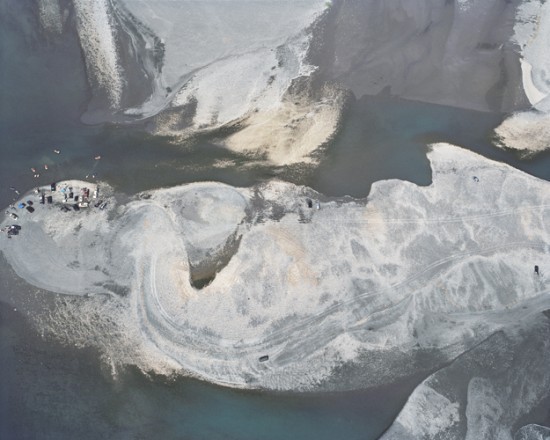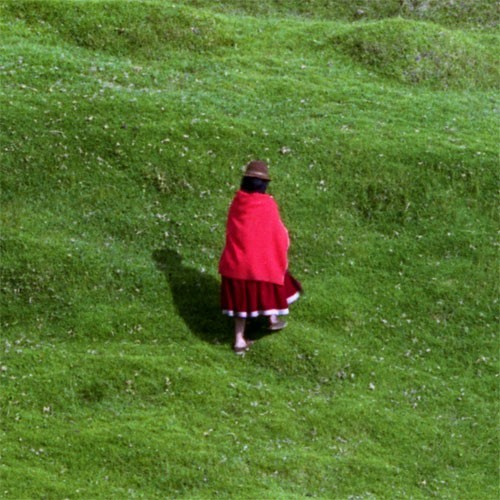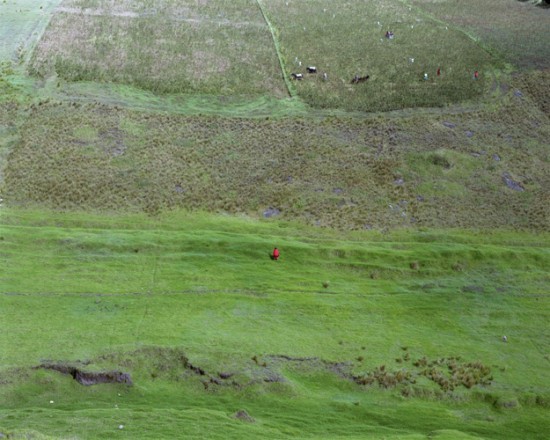Moving Photographs: Taiji Matsue’s ‘survey of time’ (Part I)
 JP-22 08 (2005), type C print, 50.2 x 61.1 cm. All images: © Taiji Matsue, courtesy Taro Nasu.
JP-22 08 (2005), type C print, 50.2 x 61.1 cm. All images: © Taiji Matsue, courtesy Taro Nasu.Digital photography has routinely been discussed as a pair-concept alongside analog photography, which is to say together they form one of the many variations of the dualism of modern photography – the real world as it is (nature, truth, the straight, analog) versus representation (the artificial, ostentation, the pictorial, digital). Essentially, however, digital photography does not fit into this framework as the true “other” of analog photography. Things like the use of digital cameras or the presence or absence of image processing are not what separate digital and analog photography.
The task of modern photography has long been regarded as to directly touch on “reality” as it is at a distance from the representative world. The photographer, eschewing any consciousness as an artist and acting in accordance with the real nature of photography as a medium, points the camera at the “reality” that appears at some decisive moment, releases the shutter, and a photograph is born. “Decisive moment,” “purity of the medium,” “a single photograph”: one moment, one genre, one photograph. Modern photography reduces the photograph to a direct manifestation of a single indivisible “reality,” to something that captures its identity. Having said that, as long as a photograph is a photograph it is also none other than a representation, so photography must essentially be photographic criticism. With this criticism serving as a motor, analog photography (ie, modern photography) is constantly circulating between two poles: the poles of “things as they are” and “image compositing,” “representation” and “abstraction” – or the poles of “straight” and “pictorial,” and so on.
At the same time, digital photography, while based on different principles (the CCD, the saving of pictorial data, and output to a medium of choice), has developed in such a way that it tends to recreate as faithfully as possible the principles of existing analog photography (projection onto a plane, erosion using light, chemical fixing of traces of this erosion), or in other words in such a way that the two are indistinguishable from each other. In the last few years, however, as the reproductive qualities of digital photography have surpassed those of analog photography – with the resolution of digital photographs now exceeding that of photographic paper, for example – digital photography has rightly begun to transform from the ground up the various notions that have constituted photography. At the heart of this transformation has been the dismantling at various levels of the aforementioned simple identity of photography and the freeing up of photography from a closed, circular motion to a continuous/transversal network. Continuity means unlimited divisibility, or in other words the negation of the unit “1,” and the transversal mingling (but not melting together) of everything (including the two poles referred to above) that arises out of this.
Anything that is receptive to light and is printed/projected/pressed is a photograph. Light escapes an obscure chamber, and the photograph is no longer a single, four-cornered scrap of paper upon which something is recorded. Digital technology has permeated all genres, and the identity of photography as a single genre has disappeared. Just as a single sound can be divided into countless harmonics, a single entity can be divided up further, a single image turning into multiple images while remaining intact. A digital photograph is singular but at the same time it also has multiple existences. It is from this that the various characteristics that separate it from analog photography emerge. In place of the exclusivity of the act of taking photographs (the capturing of “reality”) there is the complexity of the act of “looking at” photographs (photographs as photographic criticism, photographs as information analysis). Not the present perfect form (the past presenting itself), but an anachronism based on an image archive (anachronism + time-interleaving). Not “a single photograph” but a multiplicity of photographs. Photographs as installations that traverse between two and three dimensions and between different materials. As well, against a background of high-density pixel manipulation, various concepts including layers, focus, trimming, color, still and moving images are updated.
 31EC (2007), type C print, 45 x 45 cm
31EC (2007), type C print, 45 x 45 cmThe artist Taiji Matsue is at the forefront of this updating. At his exhibition “TAIJI MATSUE JP-22” held in 2006 at the Vangi Sculpture Garden Museum, Shizuoka, Matsue unveiled a series of color works that dramatically departed from the image of his work up until then, which comprised mainly detailed black-and-white photographs of landscapes devoid of people. In 2007 at Taro Nasu gallery’s branch in Osaka, he presented a collection of works entitled “cell” that consisted of square photographic objects mounted on thin sheets of acrylic, while in 2008 for his previous exhibition at Taro Nasu in Tokyo, entitled “nest,” he exhibited the “cell” pieces alongside a series of large-format photographs, whose dazzling colors and density overwhelmed viewers.
 ECUADOR 70346 (2008), type C print, 133.6 x 188.3cm (framed)
ECUADOR 70346 (2008), type C print, 133.6 x 188.3cm (framed)Let us begin by looking at “nest,” which serves as the real starting point for Taiji Matsue’s “digital photography.” Matsue’s photographs follow a rigorous format. He never takes vertical photographs, only horizontal photographs in which the horizon is absent, which has the effect of removing the depth of space and time that arises automatically as the viewer adjusts the gaze up or down, and preventing the gaze wandering beyond the horizon, repulsing any feelings of empathy on the part of the viewer and propelling everything captured by the camera to the foreground. However, these completely superficialized images do not, as many fans of Matsue’s black-and-white photographs mistakenly believe, become graphical abstract images. This is because the precise focus and high resolution that characterize these works give them a depth quite separate from the surface depth, a quality that could be called “depth of information.” If we push our way through a particular image we discover another image in the detail, and in turn this detail is packed with even further images. In his Monadology, Leibniz wrote, “Each portion of matter can be conceived as like a garden full of plants, or like a pond full of fish. But each branch of a plant, each organ of an animal, each drop of its bodily fluids is also a similar garden or a similar pond.”(1) Matsue’s color masterpieces are just such gardens, the photographs in “cell” are like branches of a plant, and both relate to each other like a “nest.”
Unlike so-called tableau photography, such as the large-format photography (soft focus, low-resolution) of people like Andreas Gursky and Thomas Struth, which in the final analysis is nothing but “painting” using photography, or the expression of color independent of sketching (ie, focus), Matsue’s color photography is linked to depth of information. In his digital photography – of which he once said, “I didn’t use color simply because I couldn’t get the focus right” – the concepts of trimming, focus and color all change. When photographs are not made by projecting and printing off an image onto a plane surface, but consist of a collection of pixels, the act of trimming is not the side-by-side movement of a small frame within the image but rather the uncovering of latent images by increasing the resolution, and focus is not the blurring and loss of focus of outlines but a question of how dense the image is, with color a function of this density. The image before one’s eyes is nothing more than a section of the latent data mass captured at a certain resolution, and both the focus and color change depending on the information level. In other words, in digital images, countless unknown images exist in the form of a “nest of boxes.”
Among the essential qualities of digital photography is the rule that singular equals plurality (plura-monity). When a single image contains multiple images, if one considers that these multiple images are superimposed over each other along an axis of resolution, then a “nest”-like continuity emerges, but what about when they are superimposed over each other on a temporal axis? This is the theme of “survey of time.” (To be continued)
Taiji Matsue’s “survey of time” was on display at Taro Nasu, Tokyo, from October 23 to November 20, 2010.
-
Gottfried Wilhelm Leibniz, The Monadology, trans. George MacDonald Ross, http://www.philosophy.leeds.ac.uk/GMR/hmp/texts/modern/leibniz/monadology/monadology.html, paragraph 67.
Archive
Critical Fieldwork: Observations on Contemporary Art in Japan 1-6
